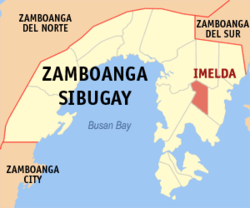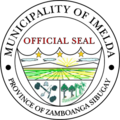Imelda | |
|---|---|
| Municipality of Imelda | |
 Map of Zamboanga Sibugay with Imelda highlighted | |
Location within the Philippines | |
| Coordinates: 7°38′34″N122°56′05″E / 7.64275°N 122.9347°E | |
| Country | Philippines |
| Region | Zamboanga Peninsula |
| Province | Zamboanga Sibugay |
| District | 1st district |
| Founded | 11 November 1977 |
| Named after | Imelda Marcos |
| Barangays | 18 (see Barangays) |
| Government | |
| • Type | Sangguniang Bayan |
| • Mayor | Roselyn V. Silva |
| • Vice Mayor | Ruth E. Roble |
| • Representative | Wilter Y. Palma |
| • Municipal Council | Members |
| • Electorate | 18,877 voters (2025) |
| Area | |
• Total | 255.51 km2 (98.65 sq mi) |
| Elevation | 76 m (249 ft) |
| Highest elevation | 454 m (1,490 ft) |
| Lowest elevation | 16 m (52 ft) |
| Population (2024 census) [3] | |
• Total | 29,652 |
| • Density | 116.05/km2 (300.57/sq mi) |
| • Households | 6,074 |
| Economy | |
| • Income class | 4th municipal income class |
| • Poverty incidence | 30.23 |
| • Revenue | ₱ 166.5 million (2022) |
| • Assets | ₱ 500.2 million (2022) |
| • Expenditure | ₱ 132.7 million (2022) |
| • Liabilities | ₱ 166.4 million (2022) |
| Service provider | |
| • Electricity | Zamboanga del Sur 2 Electric Cooperative (ZAMSURECO 2) |
| Time zone | UTC+8 (PST) |
| ZIP code | 7007 |
| PSGC | |
| IDD : area code | +63 (0)62 |
| Native languages | Subanon Cebuano Chavacano Tagalog |
Imelda, officially the Municipality of Imelda (Cebuano : Lungsod sa Imelda; Chavacano: Municipalidad de Imelda; Tagalog : Bayan ng Imelda), is a municipality in the province of Zamboanga Sibugay, Philippines. According to the 2020 census, it has a population of 26,020 people. [5]
Contents
- History
- Territorial dispute (Guintolan)
- Geography
- Barangays
- Climate
- Demographics
- Economy
- Government
- Elected officials
- References
- External links
The municipality is the least populous in the province and the third smallest in area.




